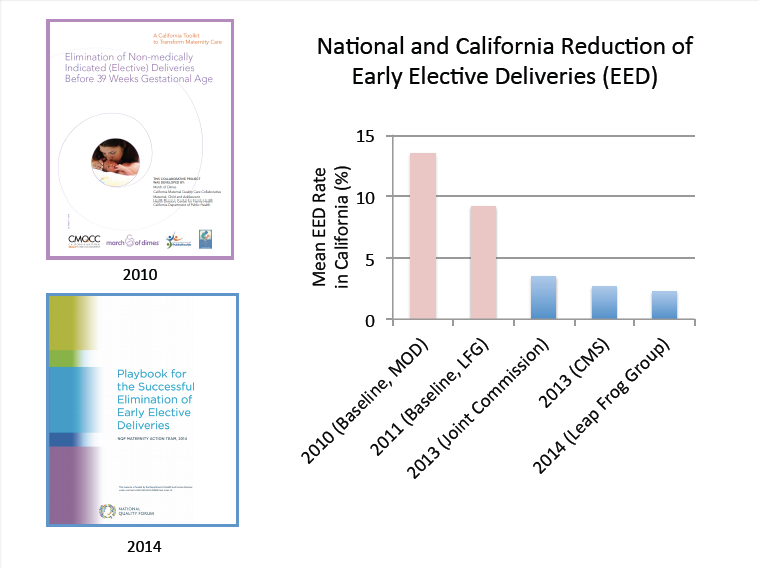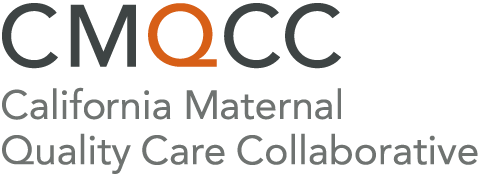CMQCC has been in the forefront of national efforts to reduce elective deliveries before 39 weeks gestational age. These elective deliveries can lead to preventable neonatal intensive care unit (NICU) admissions and increased long-term health r isks for newborns – including respiratory complications, sepsis and hypoglycemia – with no known benefits to the mother/birth parent or newborn.
isks for newborns – including respiratory complications, sepsis and hypoglycemia – with no known benefits to the mother/birth parent or newborn.
Together with the March of Dimes and the California Department of Public Health, Maternal, Child, and Adolescent Health Division, CMQCC produced a quality improvement toolkit, Elimination of Non-medically Indicated (Elective) Deliveries Before 39 Weeks Gestational Age: A California Toolkit to Transform Maternity Care. The goals of the toolkit were to determine best practices for prevention of early deliveries and to outline the most effective strategies for supporting California health care providers in implementing those practices.
The National Quality Forum also developed a related publication, the Playbook for the Successful Elimination of Early Elective Deliveries, to help hospitals implement strategies to reduce early elective deliveries.
Both are available to download in the Toolkits section of our website. Following the release of the toolkit and playbook, an additional 8 percent of births were reported as making it to full term in California -- with 120,000 early births prevented from 2009 – 2014.
Elimination of Non-medically Indicated (Elective) Deliveries Before 39 Weeks Gestational Age Toolkit
The CMQCC Early Elective Delivery Task Force worked collaboratively with the March of Dimes and the California Department of Public Health-Maternal, Child, and Adolescent Health Division, to create the Elimination of Non-medically Indicated (Elective) Deliveries Before 39 Weeks Gestational Age Toolkit. The goals of the Toolkit are to decrease deliveries before 39 weeks in California and to help disseminate and determine best practices for prevention of early deliveries and to outline the most effective strategies for supporting California health care providers in implementing those practices. This toolkit quickly became the national model.
Download Elimination of Non-medically Indicated (Elective) Deliveries Before 39 Weeks Gestational Age: A California Toolkit to Transform Maternity Care (2010)
Beginning April 30, toolkits and related resources on our website will require a CMQCC Account login. First, locate the toolkit/resource on the website. Click on the toolkit/resource, and you will be prompted to log in or create an account. After you’ve logged in, you’ll automatically see an option to complete the download. Questions or need help? Email us at info@cmqcc.org. (Note: This is a different email than for MDC support!)
Individual sections of the toolkit are also available for download:
- Title Page
- Table of Contents
- Acknowledgements
- Making the Case (NOTE: Errata#2: 8/31/11 to the toolkit under "Elective Deliveries a Growing Concern", PAGE 5. Please see Errata #2 Summary document for an outline of the changes.)
- Implementation Strategy
- Data Collection /QI Measurement
- Clinical Education
- Patient Education
- Appendices Listing (summary)
- Appendix A: Form 3 - Induction/Cesarean Section Delivery Scheduling Form
- Appendix A: Form 4 - Scheduling Process Form
- Appendix A: Form 5 - Consent Form
- Appendix B: Case Studies
- Appendix C: Form 6 - QI Tools - MAP-IT Worksheet
- Appendix C: Fishbone Diagram
- Appendix C: PDSA Method
- Appendix D: Letters of Support
- References
Related Publications
The National Quality Forum developed the Playbook for the Successful Elimination of Early Elective Deliveries to help hospitals implement strategies to reduce early elective deliveries.
Funding Acknowledgement
This toolkit is an update to the Improving Health Care Response to Obstetric Hemorrhage, V2.0 Toolkit, funded by the California Department of Public Health in 2015 and supported by Title V funds.
